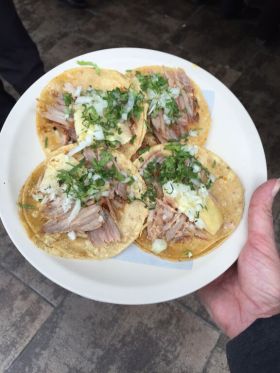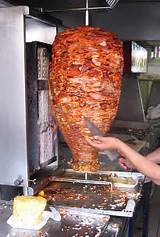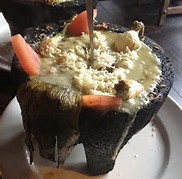What are the most popular, typical or famous foods of Mexico?
Vanessa Kerr
 There is a very wide array of traditional dishes in Mexico, generally specific to each region and faithful to their endemic ingredients. Tacos, the most popular and most famous food of Mexico, originate from the central area of the country. Unlike the version that many foreigners will know, tacos in Mexico City are made with soft corn tortillas rather than flour (which are more common in the north), and are filled with different ingredients. They're the perfect street food,...
There is a very wide array of traditional dishes in Mexico, generally specific to each region and faithful to their endemic ingredients. Tacos, the most popular and most famous food of Mexico, originate from the central area of the country. Unlike the version that many foreigners will know, tacos in Mexico City are made with soft corn tortillas rather than flour (which are more common in the north), and are filled with different ingredients. They're the perfect street food,... There is a very wide array of traditional dishes in Mexico, generally specific to each region and faithful to their endemic ingredients. Tacos, the most popular and most famous food of Mexico, originate from the central area of the country. Unlike the version that many foreigners will know, tacos in Mexico City are made with soft corn tortillas rather than flour (which are more common in the north), and are filled with different ingredients. They're the perfect street food, designed to be eaten standing up and smothered in the countless varieties of salsas offered by vendors.
There is a very wide array of traditional dishes in Mexico, generally specific to each region and faithful to their endemic ingredients. Tacos, the most popular and most famous food of Mexico, originate from the central area of the country. Unlike the version that many foreigners will know, tacos in Mexico City are made with soft corn tortillas rather than flour (which are more common in the north), and are filled with different ingredients. They're the perfect street food, designed to be eaten standing up and smothered in the countless varieties of salsas offered by vendors. Another popular dish in Mexico is pozole, which is a soup made with hominy (dried corn) and different broths. It's generally served with pork or chicken, although you can kind vegetarian versions, and its always served with a wide array of condiments such as radish, lettuce, onion, oregano and spicy salsas. Pozole is a very traditional dish that goes back to the time of the Aztecs.
Mole is another famous dish in Mexico. It is a combination of different spices to make a very thick sauce that is usually served over turkey, chicken or enchiladas. The most popular type of mole is the one that has some chocolate in it, which originated from the eastern area of Mexico City, called Puebla. There is also the black mole, which comes from Oaxaca, and then there are other regional versions of mole in other places of Mexico.
In the northern part of Mexico, they have a popular dish called burritas, which is not the same thing as the Tex Mex burritos. Burritas are made using soft flour tortillas and are usually filled pureed beans and melted cheese. That same area of Mexico is famous for its beef and is the equivalent to Alberta beef in Canada.
In the south, in the Yucatan, there is a very delicious traditional food called cochinita pibil, which is a very famous dish made of suckling pork, marinated in a sauce made of different spices, which is quite tasty.
While in Mexico we have a pretty consistent climate year round, the seasons are marked with the introduction of traditional dishes. At Christmas time, we enjoy a dish called Romeritos, which are sprigs of a wild plant known as “seepweed” served in mole with dried shrimp cakes and potatoes. For the month of independence, we serve Chiles en Nogada, poblano peppers stuffed with meat and bathed in a nut sauce with pomegranate seeds sprinkled on top, representing the green white and red of the Mexican flag. Then there's Pan de Muerto, a sweet bread made to look like a pile of bones, enjoyed during the Day of the Dead festivities.
(Tacos al pastor, Mexico, pictured.)
Posted November 9, 2015
Bruce Fraser
 For North Americans, the most popular or famous foods in Mexico are the steaks and the seafood. If you're not a meat eater when you come to Mexico, you'll be a meat eater when you leave because the price of steaks and hamburgers is very, very reasonable and generally of pretty good quality.
For North Americans, the most popular or famous foods in Mexico are the steaks and the seafood. If you're not a meat eater when you come to Mexico, you'll be a meat eater when you leave because the price of steaks and hamburgers is very, very reasonable and generally of pretty good quality. Mexicans are big meat eaters and just about everything has some kind of meat in it; maybe chopped steak or something in their tacos. They like their meat.
... For North Americans, the most popular or famous foods in Mexico are the steaks and the seafood. If you're not a meat eater when you come to Mexico, you'll be a meat eater when you leave because the price of steaks and hamburgers is very, very reasonable and generally of pretty good quality.
For North Americans, the most popular or famous foods in Mexico are the steaks and the seafood. If you're not a meat eater when you come to Mexico, you'll be a meat eater when you leave because the price of steaks and hamburgers is very, very reasonable and generally of pretty good quality. Mexicans are big meat eaters and just about everything has some kind of meat in it; maybe chopped steak or something in their tacos. They like their meat.
An example of traditional food in Mexico is what they call Arrachera steak. It's typically very tender, sliced thin. You get a big slab of it on your plate. It does not weigh more than a six-ounce fillet cut thick, but it's presented much differently. The same thing with chicken; they'll slice the chicken breast thin and sauté it, and that's very popular. Shrimp and various seafoods are pretty readily available and very popular.
Arrachera is more the style of cutting and cooking the steak. It's cut from what we would use as a roast. The way Mexicans slice it is they flip it over. They don't slice it right through. They slice about half an inch from the edge, flip that over, slice it back again, and keep flipping it and slicing it. It ends up with this big piece of meat in terms of circumference, but it's not very thick.
There's also pork or lamb on skewers. Mexicans roast them vertically, just like the Greek style of slicing it off and putting it on a taco. That's Tacos al Pastor. “Al pastor” refers to the type of meat that they use and that's usually pork. They'll also have goat or lamb that are smaller versions of the same thing. They serve this on a plate as well, not just in a taco.
A unique feature in Mexican cuisine is the rotisserie or barbecued chicken. It would be like the Western version of Colonel Sanders where you go in and they have a big roasting oven. Mexican restaurants have maybe 30 chickens in this oven. They start them up early in the morning and let them roast for four or five hours. About noon or one o'clock, people start going in to buy one. Along with the chicken, you get some tortillas, some coleslaw, rice, and salsa; a package deal. It used to be a deal. It used to be 50 to 60 pesos (US $2.60 to $3.20). Now you're spending 150 to 160 pesos ($8 to $8.50) for a whole chicken that will serve a family of three or four.
In one of the restaurants in Ajijic, El Pechugon, it's 70 pesos ($3.70) for half a chicken, great roasted potatoes, tortillas, salsa, and something else. It's enough for two or three people easily. There's no way you could eat it by yourself.
Another traditional food is Carnitas, which is basically chopped steak, which can be pork or beef, usually served in a tortilla or as a taco. It's meat that's got most of the fat and grizzle taken off. They chop the meat up and cook it on the griddle. One of the problems that you run into when you go to a taco stand is that the meat's already cooked and chopped up. When they cook it and chop it up in advance, you can't tell how much fat has been in it and how much is grizzle and uneatable stuff. You take a bite and you spit out half of the bite because of the stuff you can't chew. Carnitas refers to meat in which all that has been removed. You should be getting higher quality contents in your taco.
(Meat for tacos al pastor, Mexico, pictured.)
Posted May 29, 2017
Michael Eager - La Nueva Posada Hotel & Restaurant
 Every area in Mexico has its popular dish.
Every area in Mexico has its popular dish. Jalisco is famous for "birria", which is goat meat in a broth. Birria is the number one dish for the whole state of Jalisco. If you go to a wedding and baptism in Jalisco, you invariably are going to get birria.
There are two ways to have birria. The traditional way is to have it in a broth. You can also have it as a "birria tatemada" where the goat meat is put on trays and cooked in an...
 Every area in Mexico has its popular dish.
Every area in Mexico has its popular dish. Jalisco is famous for "birria", which is goat meat in a broth. Birria is the number one dish for the whole state of Jalisco. If you go to a wedding and baptism in Jalisco, you invariably are going to get birria.
There are two ways to have birria. The traditional way is to have it in a broth. You can also have it as a "birria tatemada" where the goat meat is put on trays and cooked in an old-fashioned adobe or brick oven that's fired up with wood. They pull the trays out and baste the meat with the birria sauce. With the tatemada, you have the cooked meat and a bowl of birria sauce that you need to eat with "frijoles refritos" (refried beans).
Frijoles are made special with lard, chorizo, and Mexican dried peppers, and then there's this whole process of refrying the beans, which is most important for Mexicans.
There are also handmade tortillas, for which they use "masa" (corn flour). The girls form the tortilla and put it on a clay "comal" (flat griddle) over an open fire.
Another dish is "Mole Dulce". Mole Dulce is chocolate mixed with different types of hot peppers and is good to eat. Most móles (Mexican sauces) started in the state of Puebla. Mexico has about 50 different types of moles..
Another typical dish is the "Pipián", which is a sauce that's made with sunflower seeds. It tastes almost like a Thai peanut sauce. It is a creamy, smooth, and not overly spicy sauce.
Jalisco is also famous for "tortas ahogadas" (salsa-drowned sandwiches). There is a big "bolillo" (Mexican roll) that they open. Then they prepare the meat "carnitas" (little meat) style in a big copper pot, melt down the lard, and then throw in all of the chunks of pork meat, including the heart, intestines, and other innards. The secret is to get the lard boiling and mix in Coca-Cola to make it more liquid. Then whole medium-sized onions are thrown in the stock. The stock and meat is boiled, and then they take the meat and chunk it up. The meat is put in the torta and Mexican bread and bathed with all of the red tomato sauce. This dish is served in a bowl. You can go all over Mexico and you will find Tortas Ahogadas Jalisco, which is another typical Mexican dish.
We used to have the "Pescado Blanco" (Whitefish) here in Lake Chapala. Now, we could only get Whitefish on the other side of the lake. They would serve the fish in an egg batter. The Pescado Blanco, with the head still attached, is splayed open.
The most popular spice and one of the mainstays in Mexico is "achiote". This would be the base of a sauce. For example, a shank basted in achiote sauce is one of the most popular dishes anywhere in Mexico. The traditional way in the Yucatan peninsula would be to baste the meat with achiote sauce, and then the meat is wrapped in banana leaves and cooked while wrapped.
Up on the border, the chimichanga and that kind of stuff mostly were created in the United States by the Tex-Mex community and adapted to the American palate. Here in Mexico, flour tortillas aren't even popular because everybody wants corn tortillas. Up in the States, they use flour tortillas. The idea is to make burritos filling so they use flour tortilla and fill it up with beans, rice, fillers, a small amount of meat, and cheddar cheese. In reality, cheddar cheese is not a popular traditional ingredient for burritos in Mexico.
Another Tex-Mex dish that did not really exist in Mexico before is the fajita. You can get fajitas everywhere now in Mexico, but it's a gringo dish. A fajita was developed and created as they started to find new uses for brisket because the brisket is somewhat garbage meat in the States. Somebody got the idea of marinating the brisket, vacuum-packed it, and this was the meat traditionally used for making fajitas. In the places I go to in Texas, I just go for the fajitas.
The closest dish to a fajita in Mexico is called the "molcajetes fajitas". This dish is served on a "molcajetes" (mortar or rock bowl). An example of rock they use is "Piedra de Castilla", which is a special stone that's incredibly hard. There are villages in Mexico where they make these rock bowls and are traditionally used as mortar and pestle.
What they would do with the molcajetes fajitas is they cook the meat, mix the onions and other ingredients, and serve it on a molcajetes with a little sauce and some of the Oaxaca cheese. The preparation style of Oaxaca cheese is to stretch it to long pieces, make big cheese balls, and wrap them. They take a strand of the Oaxaca cheese like string cheese and they would mix it up in the bowl with the meat. The molcajetes that just came from the oven would be so hot that anything you put in it sizzles.
(Fajita Molcajete, Mexico, pictured.)
Posted December 10, 2017



